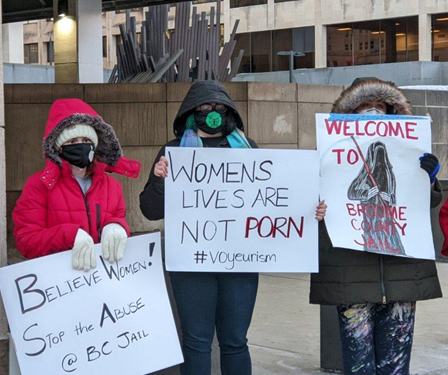
For those fighting mass incarceration in Broome County the past two years have been tumultuous, combining repeated street protests, legislative reforms and rollbacks, falling and rising incarceration numbers, and fear-inducing responses by the police, sheriff, and elected officials.
Much revolves around our jails, the gateways for mass incarceration. What is happening, where are we headed? Delayed figures from the NY State Division of Criminal Justice Services (DCJS) show that in the last year the number incarcerated in jails has risen about 10% in New York City (NYC) and outside NYC. Far more persons are now incarcerated outside NYC (9,744) than in NYC (5,270, mainly Rikers).
Broome County: up, down, and highly racialized
Broome County, with one of the largest jails outside NY City, has long had the scandalous record of having the highest jail incarceration rate among all the state’s 62 counties including New York City. In December 2021 the number of persons incarcerated stood at 398, a 4% increase over a year ago. These numbers represent a slow uptick after years of pressure to push jail incarceration lower. In 2017 the average daily jail population was over 500, by April 2020 it had fallen below 300. These trends reversed after reforms, rollback of reforms, and COVID as the following graph of long-term trends suggests.
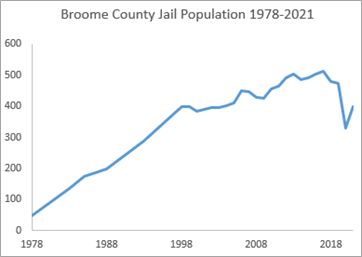
One result of the recent increase: incarceration in Broome County is now even more racialized. Black persons are 6% of the county population. Data Vera obtained by a freedom of information request (FOIL) show that the Black percentage of the incarcerated rose from 33% before bail reform in March 2019, to 38% in February 2020 after bail reform went into effect, and 42% in June 2020 after COVID hit. The figures are even more disproportionate for those sent to state prison from Broome County: 46% were Black, and 5% Latino (4% of county population).
And women? We don’t know since that record, like so much about the jail, is hidden—it takes a lengthy Freedom of Information Request. Vera obtained past figures that get us to mid-year 2018, before legislative reforms and COVID. The rising numbers are undeniable however:
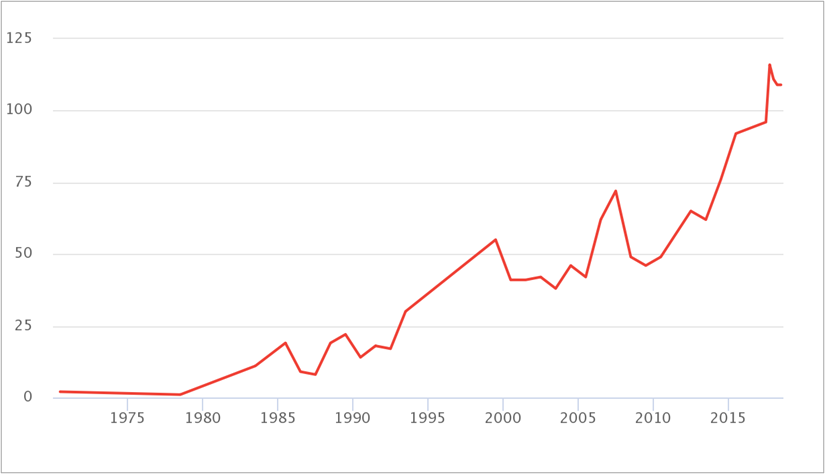
More recently the passage and coming implementation of the Less is More act, which reduces persons incarcerated for technical parole violations (e.g. missing a parole meeting), promises to reduce the number of parole violators.
Update on Gender and Race (February 17, 2022)
A freedom-of information-request subsequently submitted to the State Commission of Correction generates updated gender and race figures for the last five years. Women represented the following percentages of persons incarcerated in the jail at the end of these years, with slight falls during the Covid era:
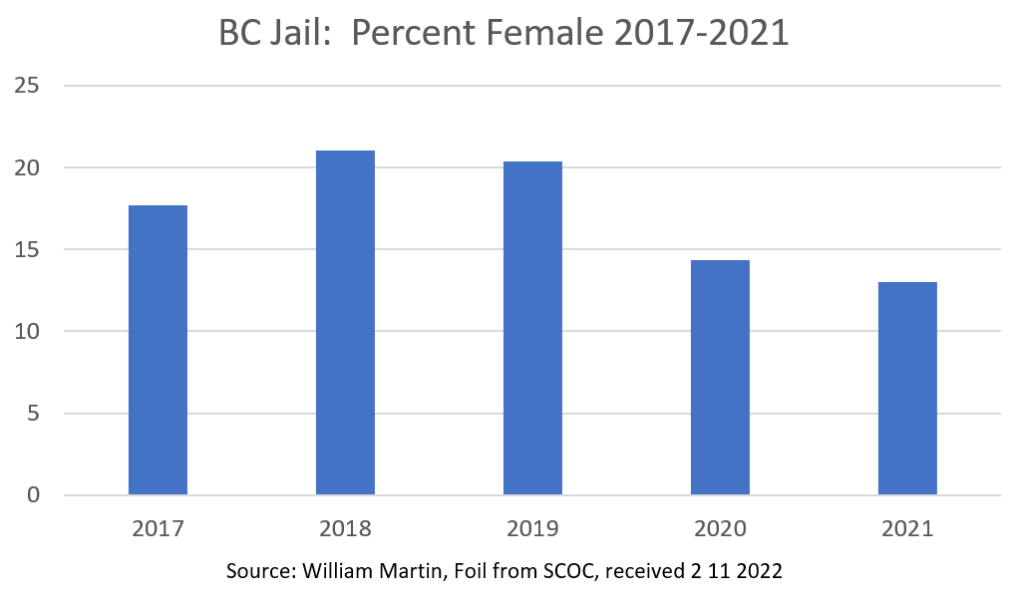
Among women admitted to the jail over the whole year from Broome County, Black women remain over represented:
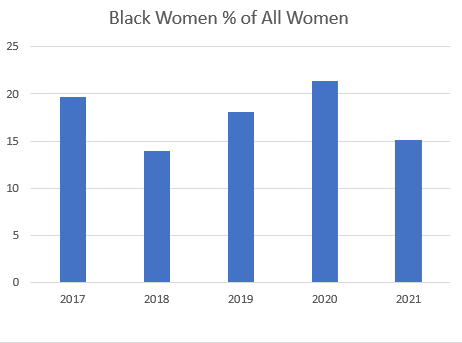
Black persons, 6% of the 2020 county population, are vastly over represented as these figures for black men and women admitted to the jail from the county indicate:
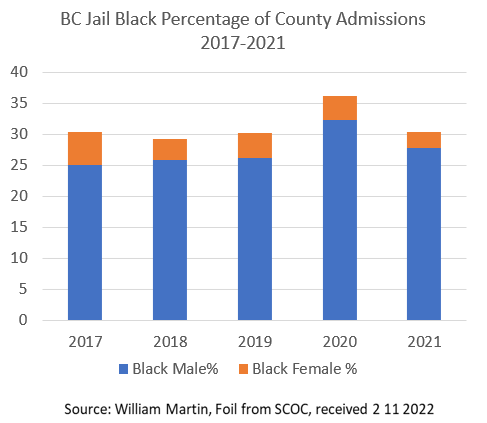
COVID Impact?

COVID exacerbated deadly conditions in Broome County’s jail: social distancing was impossible, PPE was rarely provided, infection rates were exceedingly high, and testing and vaccination rates remain low as reported here. Community organizations led by Justice and Unity for the Southern Tier (JUST) launched a long series of outdoor, socially distanced and masked rallies outside the County Executive’s media briefings, pressing for releases and better conditions inside.
COVID’s impact increased the incarcerated population as courts closed, the number of persons awaiting trial swelled, and the state stopped transfers of sentenced persons from jails to state prisons. It will take more study, but the timing and impact of reform, rollback, and COVID are clear in month-to-month jail figures:

Rising Costs and Profiting from Selling Cells
Despite falling numbers in the jail, the number of staff and funding have both risen steadily under Democratic and Republican County Executives alike. The cost of keeping a single person in the jail for a year has risen to $90,000 in 2020 from $51,000 in 2016. As explicitly expressed every year in the county budget, a key county aim has been to profit from selling “available space to generate revenue by housing prisoners for the U.S. Marshall’s Service, U.S. immigration, and Customs Enforcement “(2020, p. 157). The county now gets more than $200,000 in payments for December 2020 alone–especially from the 27 Federal and 35 state readies awaiting transfer to state prisons ($100/day).
Looking forward: a bigger or small jail? A larger or reduced incarceration budget?
Successful lawsuits against the jail, marginal improvements in medical treatment, and above all reducing the number of persons incarcerated by 20 to 40% only came about through a combination of large, repeated local protests over abuse and deaths, local investigations, protests and a hunger strike by the incarcerated, and pressure on county officials–all backing deep statewide reforms and efforts. Today we face blowback: a counter push to roll back reforms that could, if unchallenged, lead to a larger jails, new jails, and even higher jail budgets.
The Governor, NYC mayor, and most elected Republicans and Democrats have stated they agree on the need to roll back bail reform. Implementation of the HALT act which severely limits solitary in prisons and jails is likewise being promoted and resisted, primarily in NYC. Strong coalitions of advocates across the state are working to defend HALT, bail and parole reforms, and pass additional parole and related reforms. Closer to home, Binghamton Mayor David and State Senator (and likely next Sheriff) Akshar have been active locally and statewide, mobilizing forces to roll back reforms in alliance with other elected officials and guard unions. An alliance of elected officials backing rollbacks, Republican and Democrat, from NYC to upstate towns, is in formation.
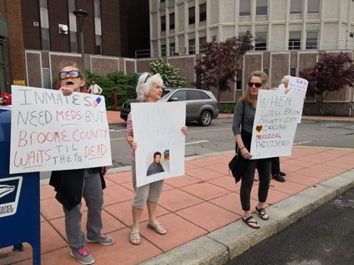
Jail Budgets and Reform
Falling jail populations have not led to smaller jails or smaller jail budgets. Despite reforms like Raise the Age, which removed juveniles from the jail, Broome County has repeatedly increased the number of jail officers and the jail budget. (Note: Governor Hochul has put provisions in her new budget to bring many youth back into adult jails.) This is part and parcel of the build-it-and-they-will-come effect. A big new BC jail was authorized and opened in 1996 and expanded again in 2015 to hold 600 persons using, as stated in even this year’s county budget, “the use of double celling, where possible, to control costs.” This is now justified in practice by turning single-celling into a COVID necessity. Will the State Commission of Correction, which has long dictated jail expansion and staffing, use this logic to require the expansion of current jails and even building new ones? We don’t know.
Sheriffs and elected officials have also been adept at turning medical, mental health, and disability ‘reforms’ to increase the funding and power of county jails, police, and courts. No one to my knowledge has examined the possible impact upstate of the HALT bill that restricts solitary, a bill community organization including JUST strongly support. HALT requires large jails like Broome County’s to create additional treatment units and protocols for the young and those with mental illnesses and disabilities. How this will be done outside NYC is unknown. It can easily be translated into more special units in jails, requiring more guards, pods, dorms, and funding. While NYC and the state can be forced to fund these new units in their jails and prisons, the lack of funding means struggles will erupt in small counties. The expansion of medical assisted treatment in the face of the opioid epidemic and deaths looms even larger as a site of power and contestation. Sheriffs have responded to revelations of medical abuse and deaths by demanding (1) increased medical services in jails under their control and (2) tying local mental health and disability responses on our streets to police control—something likely to further advance our jails as de facto county treatment center for the poor, homeless, disabled, and Black folks.
Looking forward, we celebrate and aim for fewer and fewer persons in our jail, and greater public scrutiny over the dismaying conditions in which friends and family are trapped. Community protest continues.
*
Select Sources:
Broome County Sheriff, “Annual Report,” www.gobroomecounty.com/sheriff
Broome County, “Budgets | Broome County,” www.gobroomecounty.com/countyexec/budgets
New York State, NYS Division of Criminal Justice Services, “Criminal Justice Reports & Statistics”, www.criminaljustice.ny.gov/crimnet/ojsa/stats.htm.
U.S. Department of Justice. Bureau of Statistics, “Historical Corrections Statistics in the United States,” 1850- 1984. Washington, D.C: U.S. Department of Justice, 1986.
Vera Institute of Justice, “Incarceration Rates – Incarceration Trends – Vera Institute of Justice,” https://trends.vera.org/rates/broome-county-ny.
Pictures by William Martin
Recent Comments